The Beagle Inspire article
In 2009, the world celebrates the 150th anniversary of the publication of Charles Darwin’s On the Origin of Species. Emmanuel Reynaud revisits the story of the vessel aboard which the foundations for Darwin’s publication were laid.
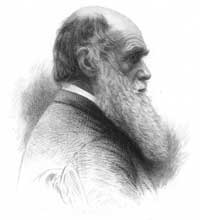
Image courtesy of Jupiterimages
Corporation
Say the word ‘beagle’ and people will automatically think of Charles Darwin. The naturalist never owned a scent hound of this breed, confining his hunting to fossils and bones rather than rabbits and hares – but the association comes, of course, from the name of one of the most famous ships in history.
HMS Beagle, the Royal Navy ten-gun brig-sloop (a sailing warship) that carried Darwin around the world in the 1830s, was first launched in 1820 from the Woolwich Dockyard on the River Thames. In July of the same year she proudly took part in the fleet review organised for the coronation of George IV, and was the first ship to sail under the newly built London Bridge.
But that, so far, was it. There was no further use for her at the time, and the ship found herself already put out to pasture; she was moored afloat without masts or rigging for the next five years. It was when the Royal Navy decided to turn her into a survey boat that the real story of the HMS Beagle began.
In May 1826, after losing a few cannons and gaining a mast, the Beagle set sail from Plymouth under the command of Captain Pringle Stokes. She accompanied the HMS Adventure on a hydrographic survey of Patagonia and Tierra del Fuego at the southernmost tip of South America
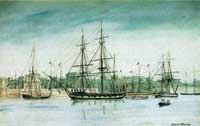
watercolour by Owen Stanley,
painted during the third voyage
while surveying Australia
Public domain image; image source:
Wikimedia Commons
As she sailed the desolate waters, her captain became melancholic and fell into a depression, locking himself in his cabin for two weeks; eventually he shot himself and died 12 days later. This wasn’t the best start for a survey boat, and this curse might have deprived the Beagle of any future, were it not for the fact that humans have an extraordinary ability to learn by experience.
Flag Lieutenant Robert FitzRoy, a 23-year-old aristocrat, was awarded the responsibility of sailing the Beagle back to England. The young man was re-appointed as captain on 27 June 1831, and the Beagle was commissioned on 4 July of that same year under his command for a second voyage to Tierra del Fuego.
FitzRoy decided that to avoid ending up the same way as Pringle Stokes, he would have to find himself a companion. He went in search of a self-financing passenger who would provide company during the voyage, ideally a geologist or a naturalist – and who should step forward but Charles Darwin, a recent graduate from Cambridge University, who wanted to visit the tropics before becoming a rural clergyman.
The outcome of that successful second voyage is well known. Darwin went into the jungle and was puzzled by the origin of its diversity. He climbed mountains and found fossils of sea shells: had the sea level been this high before, or was the Earth’s crust able to fold up to such heights? He collected birds on different islands of the Galápagos archipelago and observed swimming iguanas. He discussed his findings with Captain FitzRoy until the small hours, debating creation and struggling with this evidence that seemed to contradict his own beliefs. Returning to England in 1836, Darwin went back to his house in the countryside, and after years of struggle he published On the Origin of Species in 1859.
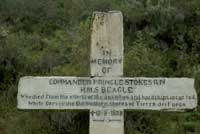
Image courtesy of Jarek Wieczorek,
Antofaya Expeditions
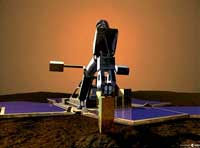
lander on the Martian surface
Image courtesy of ESA / MediaLab
While Charles Darwin tried to conquer his demons and tie his findings together in a book, the HMS Beagle set off for a further voyage in 1837, this time around the coast of Australia. Eventually, the ship’s evolution from warship to peacekeeper was complete, when it became a static coastguard watch vessel in the River Roach to control smuggling on the Essex coast. Her last years ended with a whimper rather than a bang; oyster traders complained that she was blocking their route, and she was eventually sold to William Murray and Thomas Rainer, who used her timbers to build a farmhouse.
In the following years, half a dozen ships bore the famous name; eventually, a Beagle also sailed forth into space in 2003, when the British named a landing spacecraft in ESA’s Mars Express mission ‘Beagle 2’. This time the name brought misfortune rather than glory: the spacecraft was lost before it even touched down on Mars’ surface, and either missed the planet altogether or burned out somewhere, just like poor Captain Pringle Stokes.
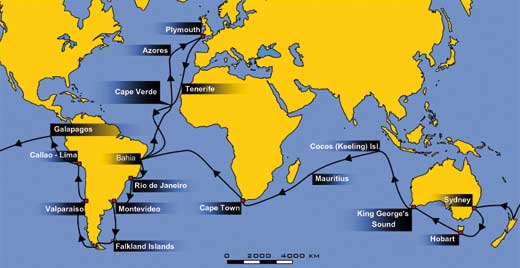
Image courtesy of Badseed; image source: Wikimedia Commons
But the Beagle is set to have its day again: the UK-based HMS Beagle Projectw1 is making plans to build a replica ship to sail the world in its wake and apply the tools of modern science to the work started by Darwin and Captain FitzRoy 170 years ago. As well as fostering international friendships and scientific alliances, the project will carry out original research in evolutionary biology, biodiversity and – perhaps most importantly – climate change.
Web References
- w1 – A replica of the HMS Beagle is planned for 2009: www.thebeagleproject.com
Resources
- The sad story of the Beagle 2 is available at: www.beagle2.com/index.htm
- The HMS Challenger carried out another major survey in 1871-1876 and became popular through the works of Ernst Haeckel and the Blaschka family:
- The Tara Oceans will survey the seas from 4 September 2009 for three years, in a modern version of the HMS Challenger expedition:





